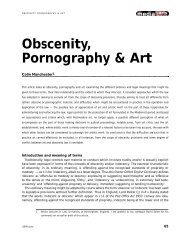Recent controversy over Phillip Gwynne's book Deadly, Unna? and ...
Recent controversy over Phillip Gwynne's book Deadly, Unna? and ...
Recent controversy over Phillip Gwynne's book Deadly, Unna? and ...
You also want an ePaper? Increase the reach of your titles
YUMPU automatically turns print PDFs into web optimized ePapers that Google loves.
Gray, ‘Imagination, Fraud <strong>and</strong> the Cultural Protocols Debate’<br />
about the feminist political opposition to pornography’. 39 These types of decisions are<br />
accepted as carrying no ‘free speech’ implications, while freedom of speech is loudly<br />
trumpeted when the question arises of suppressing the speech of the powerful. As<br />
MacKinnon points out:<br />
publishing decisions, no matter how one-sided <strong>and</strong> cumulative <strong>and</strong> exclusionary, are<br />
regarded as the way the system of freedom of expression is supposed to work …<br />
Speech theory does not disclose or even consider how to deal with power vanquishing<br />
powerlessness; it tends to transmute this into truth vanquishing falsehood, meaning<br />
what power wins becomes considered true. Speech, hence the lines within which much<br />
of life can be lived, belongs to those who own it, mainly big corporations. 40<br />
In 1983, at the request of the Minneapolis, Minnesota city council, Catharine<br />
MacKinnon <strong>and</strong> Andrea Dworkin proposed an anti-pornography law which would<br />
better reflect women’s rights to equality <strong>and</strong> freedom from discrimination. This<br />
proposal, known as the Minneapolis Ordinance, was passed by the city council but<br />
vetoed twice by the mayor. In 1985 similar legislation was passed by the Indianopolis<br />
City Council but struck down by a US Federal Court of Appeal on the basis that,<br />
although pornography was harmful to women, it was nonetheless protected speech. 41<br />
The Dworkin <strong>and</strong> MacKinnon approach was to ‘define pornography as a practice of<br />
sex discrimination, a violation of women’s civil rights, the opposite of sexual<br />
equality. Its point is to hold accountable, to those who are injured, those who profit<br />
from <strong>and</strong> benefit from that injury.’ 42 Pornography is defined ‘as the graphic sexually<br />
explicit subordination of women through pictures or words that also includes women<br />
dehumanized as sexual objects, things or commodities’ in various contexts, including<br />
rape, bestiality or torture. 43 The use of men, children or transsexuals in place of<br />
women is also defined as pornography. According to MacKinnon:<br />
39<br />
Diana E.H. Russell (ed), Making Violence Sexy: Feminist Views on Pornography (1993) 10.<br />
40<br />
MacKinnon, above n 35, 56.<br />
41<br />
Catherine Itzin, ‘Legislating against pornography without censorship’ in C Itzin (ed), above n 36,<br />
401, 416–18.<br />
42<br />
Catharine A MacKinnon, ‘Pornography, civil rights <strong>and</strong> speech’ in C Itzin (ed), above n 36, 456,<br />
465.<br />
43<br />
Ibid 465.



![ERIN O'DWYER [92] Introduction Striking a balance between ...](https://img.yumpu.com/14667367/1/184x260/erin-odwyer-92-introduction-striking-a-balance-between-.jpg?quality=85)


